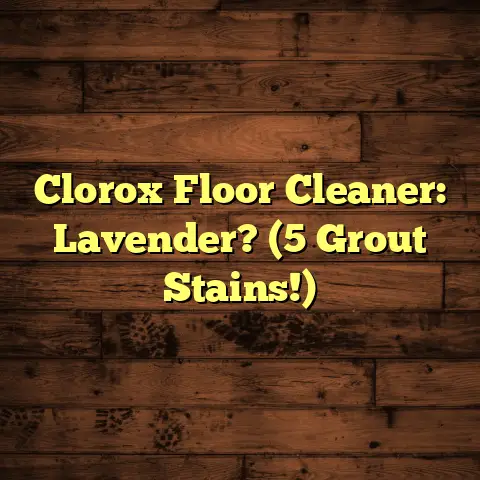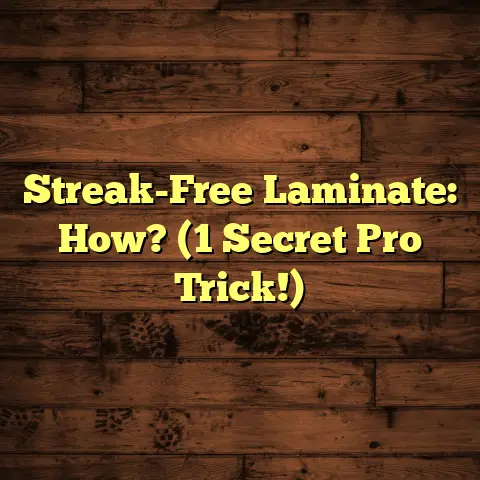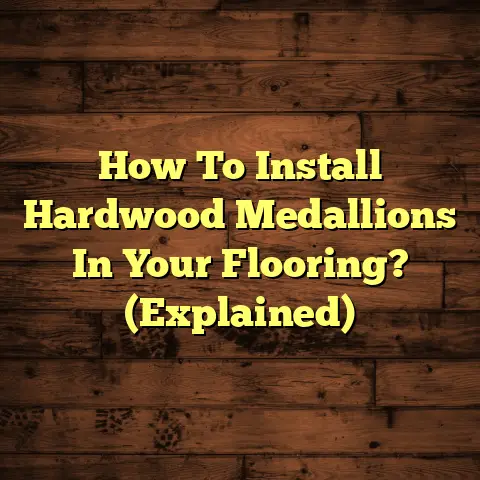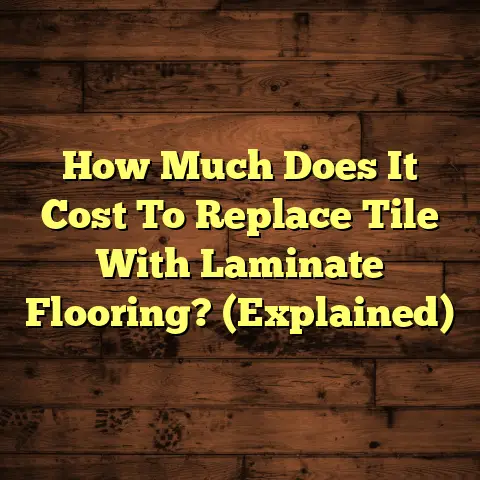Concrete Floor Damp Proofing? (9 Coatings Ranked!)
That’s where damp proofing comes in, and let me tell you, it’s becoming a huge deal in the construction world. I’ve seen it all in my years as a flooring contractor, from disastrous damp issues to floors that have stood the test of time thanks to proper protection.
Building codes are getting stricter, homeowners are wising up about mold and energy efficiency, and frankly, nobody wants to replace a floor prematurely. Plus, with climate change throwing curveballs our way, moisture levels are all over the place.
And the tech? Forget about it! We’re talking about coatings that are practically space-age compared to what we used to use.
So, let’s dive in! I’m going to break down everything you need to know about damp proofing concrete floors, and I’ll rank 9 of the top coatings on the market. Ready? Let’s get started!
Section 1: Understanding Concrete
Floor Damp Proofing
Okay, before we get into the nitty-gritty of coatings, let’s make sure we’re all on the same page about what damp proofing actually is.
1. Defining Damp Proofing
Damp proofing is basically creating a barrier that prevents moisture from seeping into your concrete floor. Think of it like a raincoat for your foundation.
Why is this so important? Concrete is porous, meaning it has tiny little holes that water can sneak through. Without damp proofing, that water can cause all sorts of problems.
2. Types of Moisture
Now, let’s talk about the different ways moisture can attack your concrete floor:
-
Rising Damp: This is when groundwater gets sucked up through the concrete via capillary action. Imagine a sponge sitting in a puddle – that’s basically what’s happening.
-
Penetrating Damp: Rainwater or other surface water can seep through cracks or imperfections in the concrete.
-
Condensation: Warm, moist air comes into contact with a cold concrete surface, causing water to condense. Think of a cold glass of water on a hot day.
3. Consequences of Ignoring Damp
Alright, so what happens if you just ignore the dampness? Trust me, it’s not pretty.
-
Structural Damage: Water can weaken the concrete, leading to cracks, crumbling, and even structural failure.
-
Mold Growth: Damp environments are a breeding ground for mold, which can cause health problems and ruin your indoor air quality.
-
Indoor Air Quality Concerns: Aside from mold, dampness can also lead to musty odors and other air quality issues.
-
Damaged Flooring: Excess moisture can damage any type of flooring installed over the concrete.
Section 2: Key Factors in Choosing
Damp Proofing Coatings
Not all damp proofing coatings are created equal. Choosing the right one can be the difference between a dry, healthy floor and a damp, moldy disaster.
1. Essential Characteristics
So, what makes a good damp proofing coating? Here are the key things I look for:
-
Permeability: How well does the coating prevent moisture from passing through? The lower the permeability, the better.
-
Adhesion: Does the coating stick to the concrete properly? Poor adhesion means the coating will peel or blister over time.
-
Durability: How long will the coating last? You want something that can withstand wear and tear, as well as exposure to chemicals and UV light.
-
Resistance to Chemicals and UV Light: The coating should be able to resist damage from common chemicals and the sun’s UV rays.
2. Surface Preparation and Application
Listen up, because this is crucial. Even the best coating won’t work if you don’t prep the surface properly.
-
Cleaning: Remove all dirt, dust, oil, and other contaminants.
-
Repairing Cracks: Fill any cracks or imperfections in the concrete.
-
Etching: This opens up the concrete pores, allowing the coating to adhere better.
And when it comes to application, follow the manufacturer’s instructions to the letter. Don’t cut corners!
3. Ranking Criteria
Okay, so how am I going to rank these 9 coatings? I’m going to look at these factors:
-
Performance: How well does it actually block moisture?
-
Cost-Effectiveness: Is it worth the price?
-
Ease of Application: How easy is it to apply, even for a DIYer?
-
Suitability for Various Environments: Is it good for basements, garages, or other specific areas?
Section 3: Ranking the Top 9
Damp Proofing Coatings
Alright, let’s get to the good stuff! Here are my rankings of the top 9 damp proofing coatings for concrete floors. Keep in mind that these are based on my experience and research, and your specific needs may vary.
1. Epoxy Coatings
-
Coating Name and Type: Epoxy is a two-part system that creates a hard, durable, and chemical-resistant finish.
-
Performance Overview: Epoxy coatings offer excellent moisture resistance and can withstand heavy traffic. I’ve seen epoxy floors in industrial settings last for decades.
-
Application Process:
- Prepare the surface by cleaning, repairing cracks, and etching.
- Mix the epoxy resin and hardener according to the manufacturer’s instructions.
- Apply the epoxy with a roller or brush in thin, even coats.
- Allow the epoxy to cure for the recommended time (usually 24-72 hours).
-
Cost Analysis: Expect to pay around \$3-\$7 per square foot for epoxy coatings, including materials and labor.
-
Pros and Cons:
- Pros: Excellent moisture resistance, durable, chemical-resistant.
- Cons: Can be expensive, requires careful surface preparation, not UV resistant.
-
Best Use Cases: Garages, basements, industrial floors, and areas with heavy foot traffic.
2. Polyurethane Coatings
-
Coating Name and Type: Polyurethane is a flexible coating that offers good abrasion resistance and UV protection.
-
Performance Overview: Polyurethane is not as moisture-resistant as epoxy, but it’s more flexible and UV-resistant. I often use it as a topcoat over epoxy for added protection.
-
Application Process:
- Prepare the surface as with epoxy.
- Apply the polyurethane with a roller or brush in thin, even coats.
- Allow the polyurethane to cure for the recommended time (usually 24-48 hours).
-
Cost Analysis: Polyurethane coatings typically cost \$4-\$8 per square foot, including materials and labor.
-
Pros and Cons:
- Pros: Good abrasion resistance, UV resistant, flexible.
- Cons: Not as moisture-resistant as epoxy, can be expensive.
-
Best Use Cases: Garages, workshops, and areas exposed to sunlight.
3. Acrylic Coatings
-
Coating Name and Type: Acrylic coatings are water-based and offer good adhesion and flexibility.
-
Performance Overview: Acrylic coatings are a good option for damp proofing. I’ve used them in residential basements with great success.
-
Application Process:
- Prepare the surface as with epoxy.
- Apply the acrylic coating with a roller or brush in thin, even coats.
- Allow the acrylic coating to cure for the recommended time (usually 24-48 hours).
-
Cost Analysis: Acrylic coatings are relatively affordable, costing around \$2-\$5 per square foot, including materials and labor.
-
Pros and Cons:
- Pros: Affordable, easy to apply, good adhesion.
- Cons: Not as durable as epoxy or polyurethane, less chemical resistance.
-
Best Use Cases: Basements, residential floors, and areas with light to medium traffic.
4. Cementitious Coatings
-
Coating Name and Type: Cementitious coatings are cement-based and offer good waterproofing properties.
-
Performance Overview: Cementitious coatings are designed to create a waterproof barrier on concrete surfaces. I’ve seen them used in swimming pools and other wet environments.
-
Application Process:
- Prepare the surface by cleaning and roughening it.
- Mix the cementitious coating with water according to the manufacturer’s instructions.
- Apply the coating with a trowel or brush in thin, even coats.
- Allow the coating to cure for the recommended time (usually 24-72 hours).
-
Cost Analysis: Cementitious coatings typically cost \$3-\$6 per square foot, including materials and labor.
-
Pros and Cons:
- Pros: Good waterproofing properties, durable, relatively affordable.
- Cons: Can be difficult to apply, requires careful surface preparation, not as flexible as other coatings.
-
Best Use Cases: Swimming pools, basements, and other wet environments.
5. Silicate-Based Sealers
-
Coating Name and Type: These sealers react with the concrete to form a dense, water-resistant surface.
-
Performance Overview: Silicate sealers penetrate the concrete and create a chemical reaction that makes the concrete more dense and water-resistant.
-
Application Process:
- Clean the concrete surface thoroughly.
- Apply the silicate sealer with a sprayer or brush.
- Allow the sealer to penetrate and react with the concrete.
-
Cost Analysis: These are relatively inexpensive, ranging from \$1 to \$3 per square foot.
-
Pros and Cons:
- Pros: Penetrates deeply, increases concrete density, and is environmentally friendly.
- Cons: Doesn’t provide a surface film, so it won’t hide imperfections.
-
Best Use Cases: Large concrete slabs, warehouses, and areas where a natural look is desired.
6. Polymer-Modified Cement Coatings
-
Coating Name and Type: These coatings combine cement with polymers for enhanced adhesion and flexibility.
-
Performance Overview: The addition of polymers improves the coating’s ability to withstand movement and resist cracking.
-
Application Process:
- Prepare the surface by cleaning and priming.
- Mix the polymer-modified cement with water.
- Apply using a trowel or sprayer.
-
Cost Analysis: Expect to pay between \$4 and \$7 per square foot.
-
Pros and Cons:
- Pros: Excellent adhesion, flexibility, and water resistance.
- Cons: Can be more expensive than traditional cement coatings.
-
Best Use Cases: Areas prone to movement, such as bridges, balconies, and floors with radiant heating.
7. Rubberized Coatings
-
Coating Name and Type: These coatings contain rubber polymers that provide a flexible and waterproof barrier.
-
Performance Overview: Rubberized coatings are highly flexible and can bridge small cracks in the concrete.
-
Application Process:
- Clean and prime the concrete surface.
- Apply the rubberized coating with a brush, roller, or sprayer.
-
Cost Analysis: Rubberized coatings range from \$5 to \$9 per square foot.
-
Pros and Cons:
- Pros: Highly flexible, waterproof, and crack-resistant.
- Cons: Can be more expensive than other coatings, and may require professional installation.
-
Best Use Cases: Foundations, basements, and areas where waterproofing is critical.
8. Bituminous Coatings
-
Coating Name and Type: These coatings are asphalt-based and provide a waterproof barrier.
-
Performance Overview: Bituminous coatings are commonly used for waterproofing foundations and below-grade structures.
-
Application Process:
- Clean the concrete surface.
- Apply the bituminous coating with a brush, roller, or sprayer.
-
Cost Analysis: Bituminous coatings are relatively inexpensive, costing between \$2 and \$5 per square foot.
-
Pros and Cons:
- Pros: Waterproof, durable, and cost-effective.
- Cons: Can be messy to apply, and may emit odors.
-
Best Use Cases: Foundations, retaining walls, and other below-grade structures.
9. Vapor Barrier Membranes
-
Coating Name and Type: These are sheet materials that are applied to the concrete surface to prevent moisture from passing through.
-
Performance Overview: Vapor barrier membranes provide a physical barrier against moisture.
-
Application Process:
- Clean the concrete surface.
- Apply adhesive to the concrete.
- Roll out the vapor barrier membrane and press it firmly into the adhesive.
-
Cost Analysis: Vapor barrier membranes range from \$1 to \$4 per square foot.
-
Pros and Cons:
- Pros: Effective moisture barrier, easy to install.
- Cons: Can be punctured or damaged, and may not be suitable for all applications.
-
Best Use Cases: Underneath concrete slabs, basements, and crawl spaces.
Section 4: Comparison of the Coatings
Okay, that was a lot of information! To make it easier to compare these coatings, here’s a handy table:
| Coating Type | Moisture Resistance | Application Difficulty | Cost | Longevity |
|---|---|---|---|---|
| Epoxy | Excellent | Moderate | \$\$\$\$ | Long |
| Polyurethane | Good | Moderate | \$\$\$\$ | Medium |
| Acrylic | Good | Easy | \$\$ | Short |
| Cementitious | Excellent | Moderate | \$\$\$ | Long |
| Silicate-Based Sealers | Good | Easy | \$ | Medium |
| Polymer-Modified Cement | Excellent | Moderate | \$\$\$ | Long |
| Rubberized Coatings | Excellent | Moderate | \$\$\$\$ | Long |
| Bituminous Coatings | Excellent | Easy | \$\$ | Long |
| Vapor Barrier Membranes | Excellent | Easy | \$ | Long |
Cost Scale:
- \$: \$1-\$3 per square foot
- \$\$: \$2-\$5 per square foot
- \$\$\$: \$3-\$7 per square foot
- \$\$\$\$: \$4-\$9 per square foot
Overall Findings
So, what does this all mean? Well, epoxy and cementitious coatings are your best bet for ultimate moisture resistance and durability. But they can be more expensive and difficult to apply.
Acrylic coatings are a good budget-friendly option for residential basements. And silicate-based sealers are great for large concrete slabs where you want to maintain a natural look.
Section 5: Future Trends in
Damp Proofing Solutions
The world of damp proofing is constantly evolving, with new technologies and materials emerging all the time.
Emerging Technologies
One exciting trend is the development of “smart coatings” that can respond to changes in moisture levels. These coatings can adjust their permeability to allow moisture to escape when needed, preventing buildup and potential damage.
Eco-Friendly Materials
Another trend is the increasing demand for eco-friendly and sustainable materials. Manufacturers are developing coatings that are made from recycled materials, have low VOCs (volatile organic compounds), and are biodegradable.
Consumer Preferences
Consumers are also becoming more aware of the environmental impact of their choices and are seeking out products that offer both performance and environmental responsibility.
Conclusion: The Importance of
Choosing the Right Solution
Alright, we’ve covered a lot of ground here. I hope you now have a better understanding of concrete floor damp proofing and the various coatings available.
Remember, choosing the right damp proofing solution is crucial for maintaining the integrity of your concrete floors, preventing mold growth, and ensuring a healthy indoor environment.
Take the time to consider your specific needs, budget, and environmental concerns when selecting a coating. And don’t be afraid to consult with a professional if you’re unsure which option is best for you.
By making informed choices, you can protect your floors for years to come and enjoy a dry, safe, and healthy home. Good luck!





